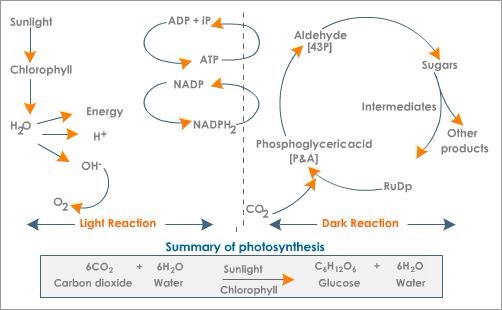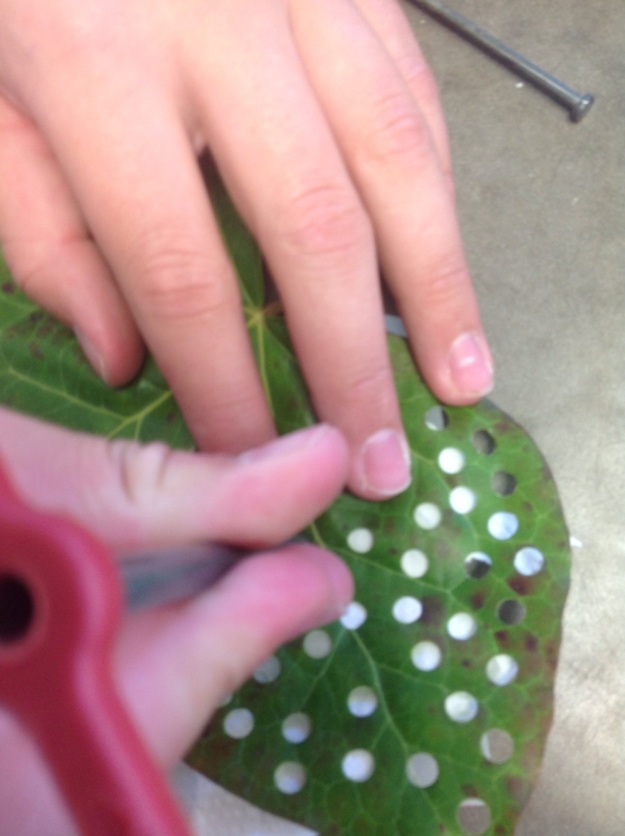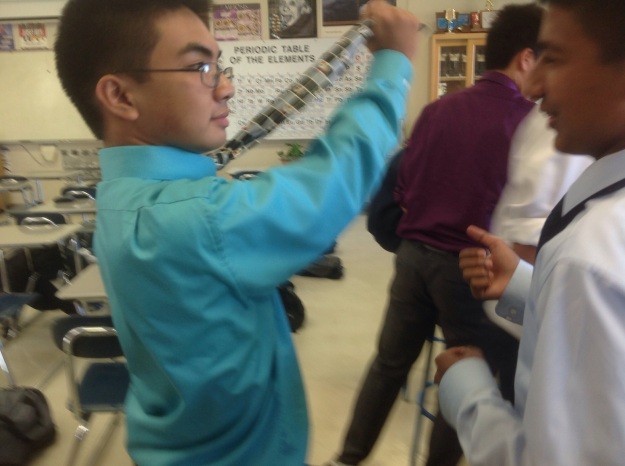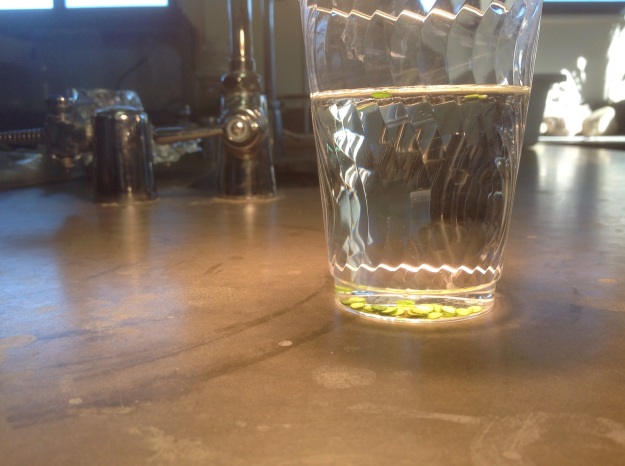In this experiment, we determined the starting substrates that leaves need to perform photosynthesis. We analyzed ivy leaves in light and dark environments, and we measured photosynthesis by analyzing the production of oxygen by the leaves. We observed that exposure to light causes leaf discs with oxygen deprived spongy mesophyll to float in water, presumably because new oxygen is produced within the discs. Our hypothesis is that light is required for photosynthesis to occur becuase leaves exposed to CO2 and light will form oxygen and glucose by photosynthesis via the equation shown in Figure 1:
Figure 1:
The leaves that are exposed to light float to the surface of a cup filled with water. The leaves deprived of light cannot initiate photosynthesis and produce oxygen, and thus do not float.
In the 1770s, Joseph Priestley demonstrated that plants release a substance that allows combustion to occur. He showed this by burning a candle in a closed system until the flame died out. He then added a spring of mint and after several days he showed that the candle can burn again. We now know that the substance released by the mint leaves is oxygen. In 1845, Julius von Mayer described photosynthesis as a process of converting light energy into chemical energy. The overall reaction of photosynthesis is:

There are two parts of photosynthesis: the light reaction and the dark reaction. Most of the proteins used in the light reaction are inside the chloroplast in the thylakoid membrane. The two parts of photosynthesis are displayed in Figures 2 and 3 below.
Figure 2
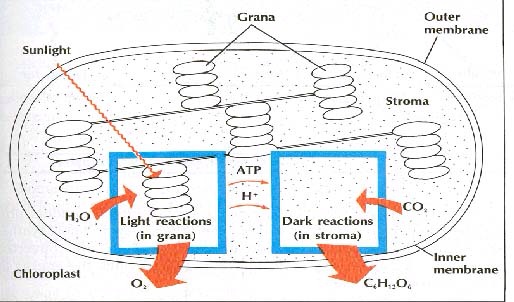
In this experiment we studied the light dependent phase of photosynthesis by indirectly measuring the oxygen produced in floating leaf capsules.
Materials
-0.2% sodium bicarbonate (baking soda)
-Hedera helix leaves
-600 ml Distilled Water
-Dishwashing detergent
-Plastic cups
-Beaker
-Aluminum foil
-100-watt lamp
-Thermometer
-Stopwatch
-Paper towels
-Camera
-Syringe without needle
Lab Set Up:
1. We took some of the leaves and hole-punched them, and we collected 100 of the resulting leaf disks.
2. Meanwhile, we mixed 0.6 g of baking soda and one drop of detergent with 300 ml of distilled water to create a 0.2% sodium bicarbonate solution.
3. We repeated step two, as we would use one for the part of the experiment that required light and another for the part that required total darkness.
4. We used the thermometer to make sure both solutions had the same temperature.
Figure 4: Hole Punching the Leaves
Removing air from the spongy mesophyll:
1. We then determined if our syringe could hold a vacuum by pressing one finger on its tip, pulling back on the plunger, and letting go to see if it popped back.
2. We vacuumed the air out of the spongy mesophyll of half of our leaves by placing them into the syringe chamber with a small amount of the solution, then repeating the vacuum step from step one.
3. We put this half of our disks into one cup of sodium bicarbonate solution and covered it with aluminum foil to prevent any light from coming in.
4. We then took the remaining disks and put them all in the syringe. After that, we drew up 2 milliliters of the sodium bicarbonate solution with the syringe.
5. With the leaf disks and the solution both in the syringe, we pulled the plunger back, sealed the tip with his finger to create a vacuum, and rocked it back and forth. After that, we pulled out the plunger.
6. We put the disks in the cup of sodium bicarbonate solution, and placed it under the lamp, which was powered on.
Performing the experiment:
1. The timer was turned on.
2. We waited patiently for one disk to float as a result of oxygen being produced within the disk.
Figure 5 and 6:
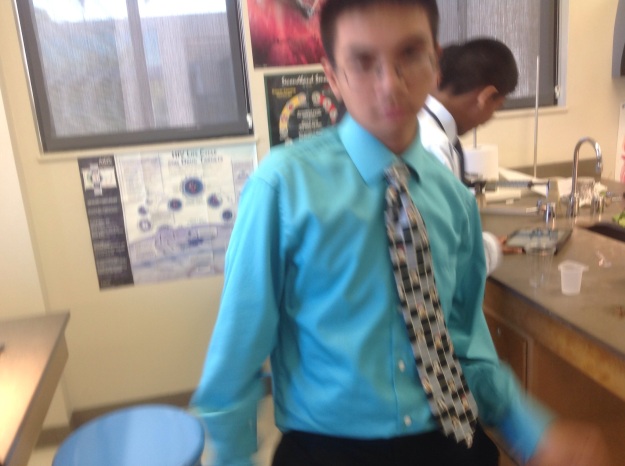
We waited patiently for our leaf disks to rise.
Figure 7:
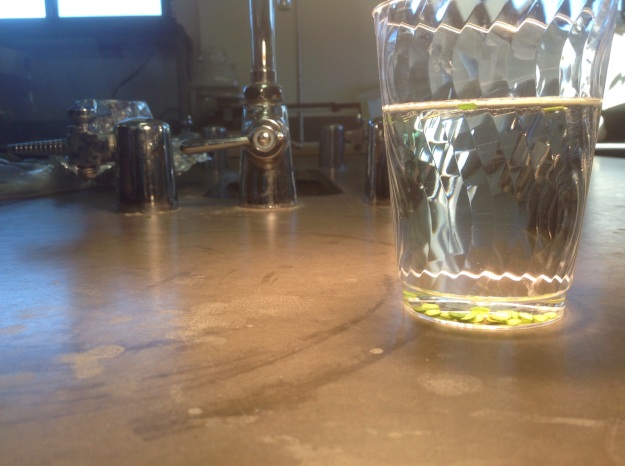
As seen in Figure 5, after six minutes, leaves began to tilt upwards from the bottom of the cup, as oxygen was produced by the leaves via photosynthesis, which made them more buoyant.
Figure 8:
As seen in figure 6, leaf disks eventually rose to the top of the solution. These leaf disks were placed in solution with sodium bicarbonate and were exposed to light. This triggered the photosynthesis reaction, which produced oxygen in the spongy mesophyll and caused the leaf to become buoyant and rise to the surface.
Graph 1
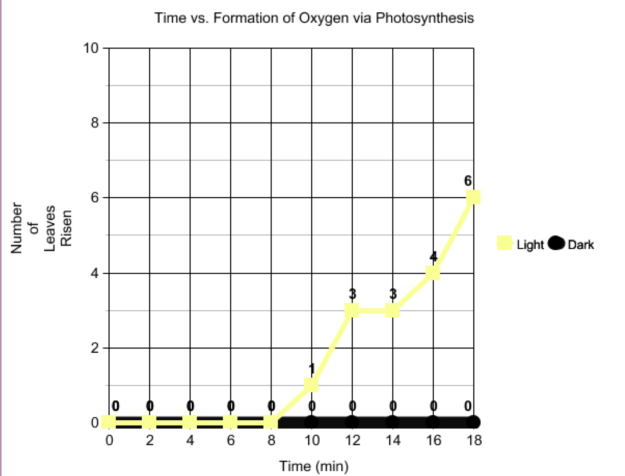
As seen in Graph 1, the y axis is the number of leaves that rose in water and the x axis is time. The black line represents leaves that had no light exposure. In this group, no leaf disks became buoyant, which indicates that no photosynthesis occurred and therefore no oxygen was formed. The yellow line represents leaf disks that were exposed to light. Between the 8 and 10 minute interval, the leaf disks began to rise. This indicates that these leaves initiated photosynthesis and produced oxygen at that time. Leaf disks continued to rise throughout the remainder of the experiment.
Table 1:
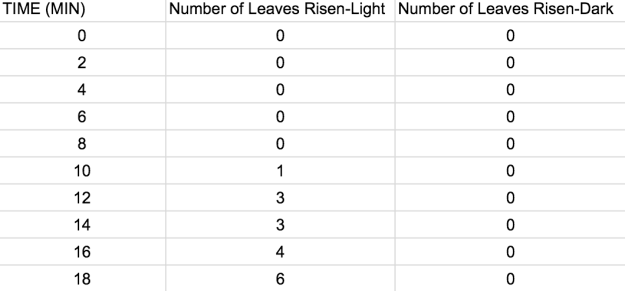
Table 1 shows the corresponding data that is illustrated in Graph 1. From this data we concluded that light is required for plants to initiate photosynthesis
1.) How does the floating-disk method measure photosynthesis? How else could you measure photosynthesis?
*The floating disk method indirectly measures photosynthesis by measuring oxygen formation, which is one product of photosynthesis. The oxygen formation was measured by observing the leaf disks in water. When photosynthesis occurred, oxygen was produced in the leaves, causing them to rise in water. Other ways to measure photosynthesis are:
1. Measuring the uptake of CO2
2. Measuring the production of carbohydrates
3. Measuring the increase in dry mass
2.) Which experimental condition yielded the highest rate of oxygen production? Why?
The experimental condition that yielded the highest rate of oxygen production was the experiment with leaves exposed to light after being mixed with dish water soap (which disrupted the lipid outer layer of the leaf) and carbon dioxide to start the photosynthesis. This facilitated access to all reactants needed for photosynthesis to occur, and led to a higher rate of oxygen production.
3.) Which experimental condition yielded the lowest rate of oxygen production? Why?
The condition that yielded the lowest rate of oxygen production was the experiment that had no light source. The leaf disks in this group had one of the necessary substrates for photosynthesis (C02) but it did not have light energy. The experimental conditions did not support photosynthesis and therefore no oxygen was produced.
4.) Do you think the rate of photosynthesis is proportional to the surface area of the disks? How would you test your hypothesis?
We think the rate of photosynthesis is proportional to the surface area of the disks. The greater the surface area, the greater the amount of starting product, light energy and CO2 that is available for photosynthesis. We could test this hypothesis by making different size discs and comparing their buoyancy over time.
5.) Light and temperature and pH are environmental variables. What are some biological variables that could impact the rate of photosynthesis? How would you test the effect of a biological variable in photosynthesis?
Biological variables that affect the rate of photosynthesis include the health of the plant, age, whether it flowers, the size of the leaves, content of minerals, leaf species; number of chloroplasts, color of leaves, and enzyme activity. We could obtain diffecnt leaves and compare them in the same experimental design to measure oxygen production based on these biological factors.
In this experiment we were able study the rate of photosynthesis using leaf disks. Leaf disks normally float, however, we removed the air from the leaf discs and removed the air from the spongy mesophyll layer, which caused the disks to sink. Sodium bicarbonate was used because it provided a source of CO2, one of the required substrates for photosynthesis. Dishwater soap was added to disrupt the lipids in the cuticle layer of the leaf, which allowed for easier diffusion of the CO2 into the stomata of the leaves. As photosynthesis occurred, oxygen was released in the interior of the leaf, and the leaves became buoyant and rose to top of the water.
Our data shows that the leaf disks that were exposed to light energy along with CO2 produced oxygen The leaves that were not exposed to light energy did not produce oxygen and consequently we observed no change in buoyancy.
If we were to do this experiment again, we would use a constant intensity light source. Our lamp varied in intensity during the experiment, which may have altered our data.
It would be interesting to explore photosynthesis using different wavelengths of light. From the graph below of wavelength and photochemical efficiency, it appears that only the far ends of the visible part of the electromagnetic spectrum are used by plants in photosynthesis. It would be interesting if we could demonstrate that using our experimental design, by using different colored light bulbs. It would also be interesting to explore mechanisms designed to increase the rate of photosynthesis, which might also increase crop production. This year in the journal Nature (Nature 513, 547–550 (25 September 2014), scientists reported successful genetic engineering of a tobacco plant to include faster enzymes to allow it to conduct photosynthesis at a higher rate than conventional tobacco leaves.
http://www.ftexploring.com/photosyn/chloroplast
http://biology.clc.uc.edu/courses/bio104/photosyn.htm
http://www.life.illinois.edu/govindjee/paper/gov.htm
http://hyperphysics.phy-astr.gsu.edu/hbase/biology/ligabs.html
Nature 513, 547–550 (25 September 2014)

